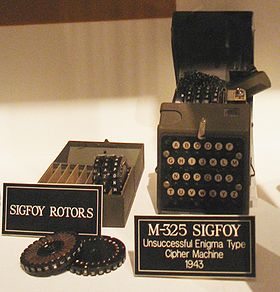
M-325
Encyclopedia

History of cryptography
The history of cryptography begins thousands of years ago. Until recent decades, it has been the story of what might be called classic cryptography — that is, of methods of encryption that use pen and paper, or perhaps simple mechanical aids...
, M-325, also known as SIGFOY, was an American
United States
The United States of America is a federal constitutional republic comprising fifty states and a federal district...
rotor machine
Rotor machine
In cryptography, a rotor machine is an electro-mechanical device used for encrypting and decrypting secret messages. Rotor machines were the cryptographic state-of-the-art for a prominent period of history; they were in widespread use in the 1920s–1970s...
designed by William F. Friedman
William F. Friedman
William Frederick Friedman was a US Army cryptographer who ran the research division of the Army's Signals Intelligence Service in the 1930s, and parts of its follow-on services into the 1950s...
in 1936. Between 1944 and 1946, more than 1,100 machines were deployed within the United States Foreign Service
United States Foreign Service
The United States Foreign Service is a component of the United States federal government under the aegis of the United States Department of State. It consists of approximately 11,500 professionals carrying out the foreign policy of the United States and aiding U.S...
. Its use was discontinued in 1946 because of faults in operation. Friedman applied for a patent on the M-325 on 11 August 1944; it was granted on 17 March 1959 (US patent #2,877,565).
Like the Enigma
Enigma machine
An Enigma machine is any of a family of related electro-mechanical rotor cipher machines used for the encryption and decryption of secret messages. Enigma was invented by German engineer Arthur Scherbius at the end of World War I...
, the M-325 contains three intermediate rotors and a reflecting rotor.

External links
- Operating and Keying Instructions for Converter M-325(T) Headquarters, Army Security Agency, July 1948, scanned and transcribed by Bob Lord.
- Friedman M-325 — information and photographs.

